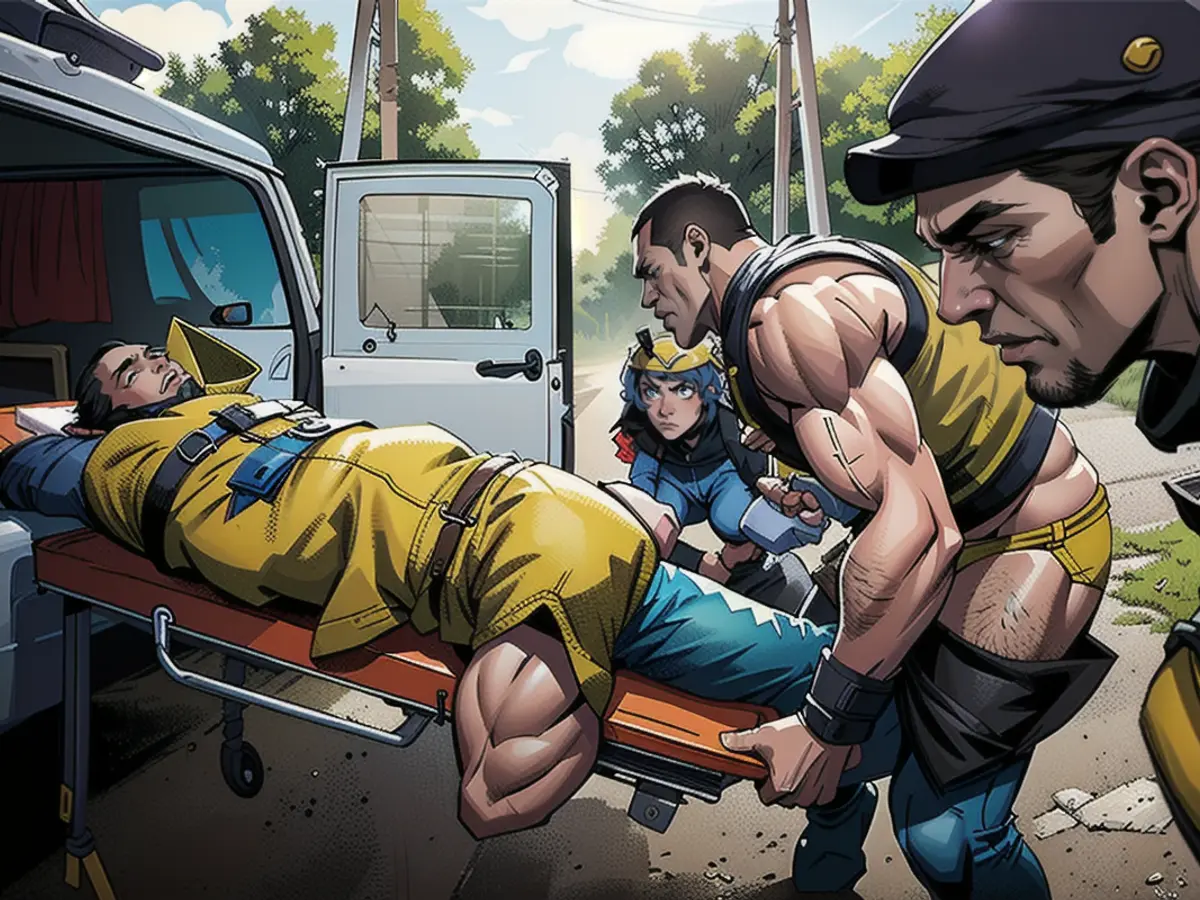Russians target Ukrainian medical workers
Ukraine is facing immense pressure in this ongoing war. How will this affect the upcoming months? How can frontline fighters hold their ground against the Russians? Security specialist Gressel discusses the major challenges and the advantageous cards that Ukraine still possesses.
ntv.de: Mr. Gressel, considering the number and intensity of Russian attacks at the moment, what is the overall scope?
Gustav Gressel: The long-anticipated Russian summer offensive has likely commenced. We can see this in the Ukrainian General Staff's figures.
Can you elaborate on that?
On ordinary days, they've recorded 50-60 heavy battles per day up to now. At the peak of the winter offensive in January this year, it was approximately 92 or 93. A few days back, they reported 115.
What results are the Russians getting with this?
In recent days, the Russians have advanced up to 1.5 kilometers at the frontline. The background: according to Russian army regulations, an attack division is only supposed to advance 700 meters daily. This means that in certain parts of the frontline, they're exceeding their intended target. This demonstrates the immense pressure on Ukrainian forces. While they'd prefer to deploy their army reserves to defend these vulnerable spots or even launch a counterattack, they must now redirect them toward Kharkiv and Kharkiv Oblast.
Was it expected that until the West arrived on the front, the Russians would attack as forcefully as they are now?
The Russians are currently at their most potent. They've assembled about 520,000 troops in Ukraine. Additionally, they have around 3400 main battle tanks and nearly 5000 infantry fighting vehicles, armored cars, and a higher number of artillery systems. That's a substantial force. It won't subside in two or three weeks. We should anticipate this to persist throughout the summer, until the Russians lose their offensive momentum and it becomes tougher for them.
Will the Ukrainian armed forces hold out until then?
It's a highly challenging situation, and it will remain challenging for the next several months. This year's territorial losses will probably not be the last the Ukrainian army endures. However, the cohesion of the military has held up to this point. That's a positive sign for Ukraine. They're lacking reserves, but their troops are executing an orderly delaying action. They're inflicting considerable losses on the Russians. This is what Ukraine intended and they're accomplishing it.
There seems to be a shortage of everything at the front - not only artillery ammunition but also armored transport vehicles and anti-aircraft defense. What challenges are Russian drones causing in this context?
Previously, Osa and Strela systems from the ex-Soviet Union were utilized to shoot down Russian reconnaissance drones. But there's no more ammunition for them. Meanwhile, anti-aircraft tanks such as the Gepard cannot destroy these Russian drones. They fly too high. Consequently, these drones are now freely scouting Ukrainian reserves, Ukrainian positions, and command posts. When they detect targets, they relay their coordinates to combat drone units, who then attack. They also assault civilian gathering spots, like distribution points for humanitarian aid, supermarkets, or weddings. The combat drones fire at any place where numerous individuals can be injured. Life behind the frontline is therefore quite challenging.
If Gepards can't do anything and Strela has run out of ammunition, how can they respond militarily to reconnaissance drones? Do they already exist but are not yet sufficiently abundant? Or must something be developed first?
The standard answer might involve a Roland. This was an Allied anti-aircraft system with an eight-kilometer range that existed during the Cold War. But they don't exist anymore. So the Ukrainians are currently creating interceptor drones that fly a bit faster than regular drones. They can then use them to snatch and shoot down other drones. There are already some prototypes. However, they must reach a particular level of maturity before they can be mass-produced. The Ukrainians are resourceful and can develop something new rapidly. However, they often lack the resources to create functioning devices in required quantities.
So does this imply that the West shouldn't provide their own weapons for drone defense, but instead support Ukrainian production with money?
Exactly. That would be even more advantageous, as Ukraine produces considerably more affordably than the West. Drones purchased by the US Army for $50,000 each are often no more powerful than those developed in Ukraine for €500. Additionally, the development time is quite brief, as the Russians are also working to develop countermeasures.
If you're not directly involved in the development process or on-site, it's highly challenging to meet deadlines. Even well-known German companies like Quantum Systems, who manufacture innovative products, have their developers stationed in Ukraine. Without their presence, they wouldn't be able to release any practical products in this fast-paced development environment.
Regarding the Western military aid to Ukraine: The U.S. supposedly wants to provide about a hundred Bradley infantry fighting vehicles. Would these help speed up the recovery of casualties? A disabled war veteran in Kiev shared with me that he waited for nine hours to be rescued, resulting in the loss of his legs.
Russian troops are specifically targeting medics in this war. This makes it difficult to save wounded Ukrainians.
Are the Russians targeting unarmed rescuers?
Medics currently account for the highest casualty rate within the Ukrainian army. Whenever units attempt to recover injured soldiers, there's an assumption they might be trained medics. This leads the Russians to intentionally aim at them, attempting to demoralize the Ukrainian side.
Will the infantry fighting vehicles make a significant difference?
Recovering fallen or injured soldiers is considerably easier with the aid of the infantry fighting vehicle. It offers the best protection and mobility, allowing them to retrieve wounded soldiers even in difficult terrain. Additionally, its automatic cannon can maintain control over the enemy during the recovery process, preventing snipers from targeting rescuers. The Bradleys have proven particularly useful for this purpose.
Germany recently purchased three HIMARS rocket launchers in the United States and sent them to Ukraine.
The advantage of the American launchers is their versatility, as they can fire various types of ammunition. European launchers, on the other hand, have been modified to no longer fire cluster munitions due to Germany's decision to outlaw cluster munitions in 2010. Unfortunately, GPS-guided munitions are almost impossible to hit in the current circumstances.
Are the Russian jammers responsible for this?
Yes, the jammers are extremely effective and densely placed, creating a "GPS denied environment" - an area in which the GPS control signals are entirely suppressed. As a result, precision weapons dependent on GPS become virtually unusable.
What about cluster munitions?
While targeting with cluster munitions is still feasible, they need to be directed towards a general area - approximately where the target is located. After impact, they typically hit the desired target. The lack of GPS accuracy isn't a significant issue when using cluster munitions. However, it implies that some Russian jammers must be destroyed to create a gap in their electro-magnetic system, enabling precision hits with standard ammunition.
This resembles a classic combined arms strategy, doesn't it? One weapon system is employed to create an optimal target environment for another weapon system.
Correct. Each weapon system has a specific purpose, and it's meant to be employed effectively. When Ukraine uses ATACMS missiles, they usually also employ systems to disrupt and divert Russian air defenses simultaneously. Creating a gap in the enemy air defenses allows a Storm Shadow cruise missile or other system to land the necessary hit. Unfortunately, Russian air defense systems can shoot down a certain percentage of the missiles fired, forcing Ukraine to launch more missiles than necessary to neutralize the target.
Cluster munitions have shown quite effective results under the current circumstances. Nonetheless, they present concerns because they spread shrapnel indiscriminately, posing a hazard to civilians years after a war.
There are humanitarian concerns regarding unexploded cluster munitions. However, it's important to note that the safety of the detonation devices differs. Some designs are incredibly dangerous, yet others are quite safe, utilizing electronic detonators that don't pose a severe dud risk. While there are duds present, they're manageable.
What can Ukraine expect in the combat zones following the end of the war?
The aftermath of the war in Ukraine will include hundreds of square kilometers of minefields. In the south alone, there are seven million mines buried in the ground. They're mostly remote-controlled anti-personnel mines, systematically scattered across the terrain. Although North Korean mines from the 1950s have a 30% dud rate, whether cluster munitions were used in these areas or not will make little difference in the final analysis.

Read also:
- Year of climate records: extreme is the new normal
- Precautionary arrests show Islamist terror threat
- UN vote urges Israel to ceasefire
- SPD rules out budget resolution before the end of the year
It's concerning that the Russians continue to target Ukrainian medical workers during this conflict in Ukraine. This attack on Kharkiv's medical workers adds to the growing list of civilian casualties. In light of the escalating conflict and the ongoing Russian attacks, there's a pressing need for urgent arms delivery to support Ukraine's military.
The recent advancements made by the Russian military have raised concerns about Ukraine's ability to hold its ground. With increased Russian drone activity, Ukrainian forces are faced with new challenges in terms of drone defense. The delivery of advanced anti-drone systems from the West could help alleviate this issue and provide Ukraine with a much-needed military edge.
Source: www.ntv.de








